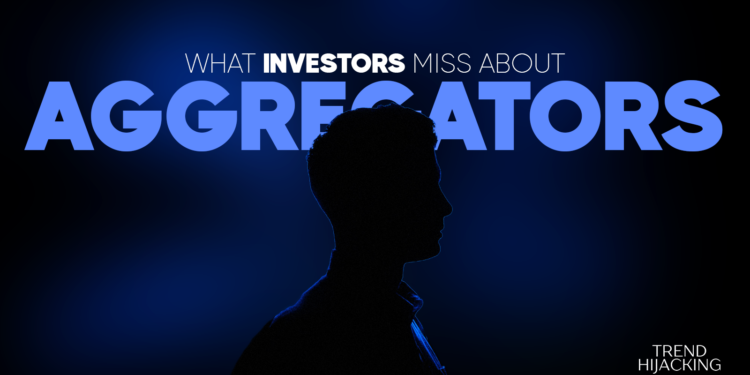In 2021, a company you’ve probably never heard of raised $3.4 billion in a single funding round. Not for AI. Not for biotech. Not for the next revolutionary app. They raised it to buy small ecommerce businesses on Amazon.
That company, Thrasio, was valued at $10 billion at its peak. By 2023, it filed for bankruptcy.
Between those two moments lies one of the most important lessons about wealth creation that most investors will never learn. Because while Thrasio and dozens of companies like it were imploding, a small group of investors who understood what went wrong were quietly making fortunes doing the exact same thing, just better.
This is that story. And if you’re sitting on capital wondering where the real opportunities are in 2025, you need to hear it.
Here’s what nobody tells you about wealth building. The richest people you’ve never heard of don’t just invest their money. They buy cash-flowing businesses, optimize them, and either hold them for passive income, cash flow or sell them for multiples of what they paid. It’s not flashy. It doesn’t make for good cocktail party conversation. But it works.
And right now, there’s a gold rush happening in ecommerce that’s creating opportunities most investors are completely missing.
Why the Smartest Money Is Moving Toward Business Acquisitions
Warren Buffett didn’t become a billionaire by buying index funds. He bought businesses. Whole ones. Berkshire Hathaway’s entire strategy revolves around acquiring established, profitable companies and improving them. As Buffett himself said, “It’s far better to buy a wonderful company at a fair price than a fair company at a wonderful price.”
The difference between buying stocks and buying businesses comes down to one word: control.
When you buy shares in a public company, you’re along for the ride. You can’t change the CEO. You can’t pivot the business model. You can’t even get them to answer your emails. You’re a passenger hoping the pilots know what they’re doing.
When you buy a business, even a small one, you’re in the driver’s seat. You control operations, pricing, marketing, and most importantly, the exit. Research from Harvard Business Review shows that investors who buy and operate small to mid-sized businesses see significantly higher returns than traditional equity investments, primarily because they can directly influence outcomes.
This is why people like Richard Branson, Mark Cuban, and Sara Blakely didn’t just invest their wealth. They built and bought businesses. Cuban has openly said that buying and building businesses is “the greatest way to create wealth” because you’re not betting on someone else’s execution. You’re executing yourself, or with a team you control.
But the problem most investors face is which business do you buy?
Do you buy a local gym? A restaurant? A manufacturing company? Each comes with steep learning curves, physical locations, inventory headaches, and slim margins. For someone with a full-time career, other investments, and a family, the idea of buying a business sounds great until you realize it might become a second full-time job.
That’s where ecommerce changes everything.
The Ecommerce Opportunity (That Doesn’t Require You to Become a Full-Time Operator)
Ecommerce businesses are different. They’re digital, scalable, and remarkably efficient compared to traditional brick-and-mortar operations. A profitable Amazon FBA brand doing $2 million in annual revenue might only need a small team, operate from anywhere, and have margins that would make a restaurant owner weep with envy.
Between 2019 and 2021, something unprecedented happened. Ecommerce exploded. Brands that were doing $500K a year suddenly found themselves doing $3 million. Sellers who started on their kitchen tables were suddenly running 7-figure operations. And a new category of investor emerged called ecommerce aggregators.
Companies like Thrasio, Perch, and Heyday raised billions of dollars (yes, billions) to do one thing, buy up profitable ecommerce brands, primarily on Amazon. Thrasio alone acquired over 200 brands. The thesis was simple. Find profitable ecommerce businesses, buy them at 3-4x earnings, optimize them with better marketing and operations, and either hold them for cash flow or sell them at higher multiples.
For a brief moment, it was a gold rush. Sellers were getting acquisition offers they couldn’t refuse. Aggregators were raising fund after fund. Everyone was winning.
Then reality set in.
What Happened When the Music Stopped
By late 2022, the cracks started showing. Thrasio, once valued at $10 billion, filed for bankruptcy restructuring. Perch laid off significant portions of its staff. Brands that were acquired for 4-5x multiples weren’t growing the way projections promised. The ecommerce aggregator model, at least in its most aggressive form, had hit a wall.
So what went wrong?
The problem wasn’t ecommerce itself. Ecommerce is still growing. Global ecommerce sales are expected to reach $6.3 trillion in 2024, according to Statista, and that number keeps climbing. The problem was execution at scale.
When you buy 200 brands in two years, you can’t give each one the attention it needs. You can’t optimize every product listing, manage every supplier relationship, or react quickly to market changes. The aggregators were playing a numbers game: buy fast, grow fast, and hope the portfolio performs well on average. But businesses, especially ecommerce brands, aren’t averages. They’re individual ecosystems that require care, strategy, and operational excellence.
The aggregators that survived and thrived were the ones that slowed down. They focused on fewer, better acquisitions. They built competent operational teams. They stopped chasing growth at all costs and started prioritizing profitability and sustainability.
And what’s interesting are the lessons from the aggregator boom and bust have created a playbook for individual investors who want to get into ecommerce without making the same mistakes.
What Smart Investors Are Doing Differently Now
The ecommerce aggregator story isn’t a cautionary tale. It’s a lesson in what works and what doesn’t. The investors winning in ecommerce today aren’t trying to buy 50 businesses. They’re buying one or two. They’re not overleveraging. They’re bringing in operational expertise from day one. And most importantly, they’re treating these acquisitions like real businesses, not lottery tickets.
Let’s talk numbers for a second. A well-run ecommerce brand typically sells for 3-4x its annual net profit. So if a brand is netting $200K a year, you might buy it for $600K-$800K. If you improve operations, expand the product line, or optimize advertising, you could grow that profit to $300K or $400K within 18-24 months. Now the business is worth $1.2 million or more. That’s a 50-100% return in under two years, and you’re generating cash flow the entire time.
Compare that to real estate, where you’re lucky to see 10% appreciation annually, or stocks, where you’re hoping the market doesn’t tank the year you need liquidity. The returns in e-commerce acquisitions, done correctly, are in a different league.
But the key phrase is “done correctly.”
You need to know how to evaluate a business. Not every ecommerce brand that’s profitable today will be profitable tomorrow. You need to understand supply chains, marketing channels, customer acquisition costs, and competitive moats. You need to know if the seller is offloading a sinking ship or a genuine opportunity. This is where due diligence becomes everything.
Then there’s operations. Once you own the business, someone needs to manage it. Are you going to do it yourself? Do you have the time? The expertise? Or are you going to hire a team? How do you find good operators in ecommerce? These aren’t small questions.
And finally, there’s the exit. When do you sell? How do you maximize the sale price? What buyers are even in the market?
This is why most investors, even wealthy, sophisticated ones, never pull the trigger on buying an ecommerce business. It’s not that the opportunity isn’t real. It’s that the operational lift feels overwhelming.
The New Model: Investing in Ecommerce Without Becoming an Operator
Here’s what the next generation of ecommerce investors figured out: you don’t have to do it alone.
Think about real estate for a second. Most wealthy individuals don’t personally manage their properties. They hire property managers. They work with real estate syndicates. They invest in funds where professionals handle the operations. The same model is now emerging in ecommerce.
There are now firms that specialize in finding, acquiring, operating, and scaling ecommerce brands on behalf of investors. They handle due diligence, they manage day-to-day operations, they implement growth strategies, and they execute exits. The investor provides the capital and gets the returns, without having to become a full-time ecommerce operator.
This is the gap that companies like Trend hijacking are filling.
Trendhijacking works with investors, entrepreneurs, business owners, and high earners who see the opportunity in ecommerce but don’t have the time or expertise to execute on their own. They handle everything: sourcing acquisition targets, performing due diligence, negotiating deals, running operations, scaling revenue, and eventually exiting at a profit.
The model is straightforward. You decide how involved you want to be. Some investors are completely passive, treating it like a managed fund. Others want to be hands-on, learning the business and being involved in decisions. Trendhijacking has structured programs for both, and everything in between.
They’ve also built an assessment quiz that helps investors figure out which path makes sense for their capital, risk tolerance, and lifestyle. Maybe you have $500K to deploy and want a passive income stream. Or maybe you have $2 million and want to build a portfolio of brands with professional operators managing them. The quiz matches you to the right investment structure.
It’s not a sales pitch. It’s a diagnostic tool. Because the truth is, not every investor should be in ecommerce. And not every investor should be passive. Some people genuinely want to be involved. The key is knowing what fits your life and your goals.
What This Means for You
If you’re reading this, you’re probably the type of person who’s already done well financially. You’ve built a career, maybe sold a business, or accumulated wealth through traditional investing. You’re not looking to gamble. You’re looking for asymmetric opportunities where the upside is real and the risk is manageable.
Ecommerce acquisitions, done right, are one of those opportunities.
The aggregator boom proved that buying ecommerce brands can generate exceptional returns. The aggregator bust proved that execution matters more than speed. The winners in this space going forward won’t be the ones buying the most brands. They’ll be the ones buying the right brands, with the right operational support, and the right exit strategy.
You don’t need to become an ecommerce expert to participate. You just need to work with people who are.
So here’s my challenge to you: stop thinking about investing as something you do with money sitting in brokerage accounts. Start thinking about it as something you do with businesses. Real, cash-flowing, scalable businesses. The kind that Warren Buffett has been buying for 60 years.
Ecommerce is just the newest, most accessible version of that strategy. And right now, the opportunity is wide open.
If you’re curious about what this could look like for you, Trendhijacking has a free assessment quiz that takes about 5 minutes. It’s not a sales call. It’s a genuine evaluation of whether ecommerce investing fits your situation, and if so, what structure makes sense.
Because at the end of the day, the best investment isn’t the one with the highest theoretical return. It’s the one you actually make. And if ecommerce is that opportunity for you, there’s never been a better time to explore it.
Take the quiz. See where you stand. And if it makes sense, let’s have a real conversation about what building wealth through ecommerce could look like in your life.
The aggregators had the right idea. They just moved too fast. You don’t have to make the same mistake.













